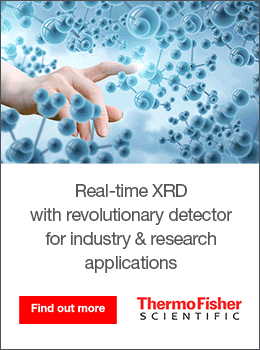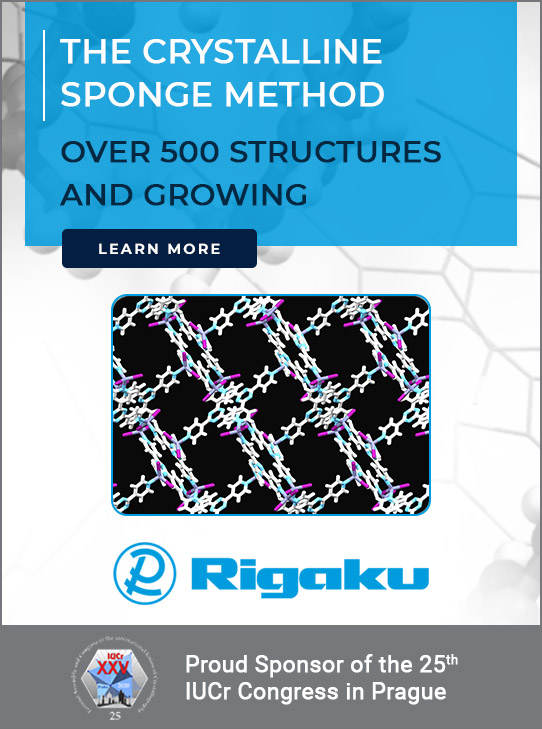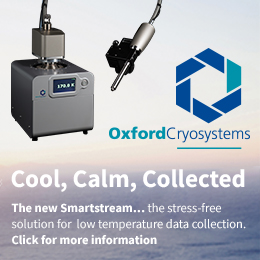
Feature article
21st century challenges: structure beyond crystals
![21stcenturythumbnail [21stcenturythumbnail]](https://www.iucr.org/__data/assets/image/0009/146457/thumbnail.png)
Largely speaking, crystallography is a solved problem. Wait, what? How can I write that as the opening sentence in an article in the newsletter of the august IUCr and not upset the entire readership of crystallographers – my colleagues? But it is a statement that we should face full on, both to celebrate and to examine for our own survival as a community of researchers. When crystallography was born at the end of the first decade of the 20th century, the very existence and nature of atoms were in question. Boltzmann died in 1906 in conflict with the powerful German positivist school of Ernst Mach without ever having full validation of his statistical mechanics through the validation of the discovery of atoms.1 The nature of X-rays was still being sorted out (Barkla, 1909) and Rutherford’s experiment to establish that the atom had all its mass in a tiny point at the center would not be published until 1911 (Rutherford, 1911). Indeed, arguably, it was the X-ray crystallography of Max von Laue, Paul Knipping and Walter Friedrich (Friedrich et al., 1913; reproduced from Friedrich et al., 1912) and the Braggs (Bragg, 1913; Bragg & Bragg, 1913), taking place in the period right before the First World War, which settled both questions: X-rays are short-wavelength electromagnetic radiation waves and, without doubt, stuff is made of Rutherford-esque atoms in regular arrangements. Over the proceeding 100 years or so, the brilliance of our radiation sources increased by many orders of magnitude; the simplifying power of applied mathematical concepts such as space-group theory (Aroyo, 2016) applied to solving atomic arrangements in crystals, and constraints coming from atomicity and the positivity of density and so on (Giacovazzo et al., 1992), made the inversion problem – given this X-ray pattern to what was the 3D arrangement of atoms – tractable.
In this period, the power of computing exploded, so that by the end of the century we were routinely solving the structures of rather large, complicated and low-symmetry proteins (Karthikeyan et al., 1999), and even larger objects like viruses (Harrison et al., 1978). Structures of straightforward inorganic and small-molecule crystals can be solved automatically, at the push of a button, on a modern laboratory diffractometer, and the biggest problem in protein crystallography is now often getting the crystals to grow rather than doing the crystallography on the resulting data. Generically speaking, this is very much the description of a solved problem: if you can make a machine that gives the answer at the push of a button, the problem is solved. So maybe it is time to pat ourselves on the back, kick up our feet and wind up the IUCr, satisfied in the warm glow of a “a good job well done”.
![[21stcenturyfig1]](https://www.iucr.org/__data/assets/image/0010/146458/Picture1.png)
However, I beg to differ. Apart from the rather large number of crystal structures that can't yet be solved at the push of a button, and the large number of future crystallographers that we need to train, we are actually facing a much more fundamental problem in structure science. Rather than kicking up our feet, we need to be rolling up our sleeves. I believe that our community, and its particular knowledge and skill set, will be as much at the forefront of solving humankind’s problems in the 21st century as they were in the 20th. The IUCr can, and should, be providing leadership to the much broader scientific community moving forward, well beyond the large shadow of its past successes. Furthermore, it will not be the IUCr in isolation but in partnership with the materials, chemistry, physics, geology and biological communities, and it will benefit us to be outward looking, as is our tradition.
Let’s explore this further by thinking about some of the biggest challenges facing humankind and our potential role in finding technological solutions to them. Climate change is a central concern. At the heart of stabilizing the situation is to move to fully renewable energy sources on the one hand, and possibly sequestering carbon on the other. These are materials science problems. Why do I say that? Most of the Earth’s energy comes from the sun, so a major aspect of sustainable energy means harvesting that energy from the sun sustainably. We know how to do this, so arguably this is already a solved problem. For example, we can turn sunlight into electricity directly by using photovoltaics. But how do we do this at scale? We need photovoltaics that are inexpensive to manufacture and that can cover vast areas of the surface of the earth without destroying our environment or killing habitats. They also need to be made of earth-abundant and environmentally friendly materials. They only work during the day, so we need to store the energy for the night time. We know how to do that, we use batteries! But we need to take these to scale, giving temporary storage to terajoules of energy. A large city uses of the order of 10 GW2 of electricity, so ten thousand million joules of energy per second. Far from the equator, in the winter, the days are short and the nights are long, so vast quantities of electrical power must be stored for this to work. It is another materials problem. We can store energy as liquid fuels. Nature did this. Sunlight was converted to electrical energy by photosynthesis and stored as chemical energy, principally in C—C bonds. The plants that were not recycled by bacteria settled in anaerobic environments turning into oil, gas and coal, fossil fuels for us to plunder later. We can replay this playbook by developing artificial processes for using the sunlight to run reactions backwards (for example, turning water into hydrogen and oxygen), but they have to be more efficient than plants because we need to be converting the energy at the same rate we are using it, not collecting it for two million years and then using it over two hundred years. This is also a materials problem: finding robust, inexpensive, earth abundant (etc.) materials for catalysing these uphill reactions. Then there is the fresh-water challenge. We know how to purify water, but what materials, in what devices, can do this at scale with manageable energy inputs and without pollution? Food. We had a green revolution that banished starvation from a technological point of view (there are excesses of food in the world right now so the presence of starvation is presumably a political and sociological issue rather than technological). But the revolution involved processes, such as the production of active nitrogen and phosphorous, that are not sustainable from an energy perspective, a CO2 emissions perspective and a raw-resource perspective, not to mention pollution of the environment with salt, nitrates and phosphates. The world population is cruising through seven billion on its way to ten billion before it will stabilize and come back down. We need another green revolution that is sustainable, but also at scale and non-polluting, to feed this new world population. Another materials problem. Disease. Again, we have cures for many, though far from all, things, but how do we bring this to scale, so that the cures are cheap and abundant?
![[21stcenturyfig2]](https://www.iucr.org/__data/assets/image/0011/146459/Picture2.png)
What is the role of crystallography, and the challenges, in this picture? It has always been the understanding of the structure–property relationship, through the intermediary of quantum mechanical models such as density functional theory (Kohn & Sham, 1965), or even just geometric insights from details of protein folds, that have led to understanding of how materials do what they do. To solve the technological problems outlined above, we need better devices built on better materials. And we need them quickly, by carrying out more targeted, less trial-and-error, materials discovery campaigns. “Structure–property relationship” contains the word structure and, no worries, we have solved the crystallography problem, right? But virtually none of the technological solutions I have hinted at above make use of perfect crystals. They use what I would call “real materials”. These are materials with defects and interfaces and heterogeneities. They can be multi-phase and nanostructured, making key use of their morphology, which is increasingly nanoscale. Many of the processes of interest, such as catalysis, take place at the surface of a supported nanoparticle, the structure of which could be very different from the crystallographic form of that same material, but even more challenging, different from the structure of the core of the same nanoparticle. The properties of materials depend sensitively on bond-length variations of the order of a few picometres to a few tens of picometres. Doped lanthanum manganite changes from an insulator to a metal when its Mn—O bond length changes by just 10 pm (Billinge et al., 1996), and just a single surface trap state, a structural defect, in a quantum dot nanoparticle, can have a large effect on its optical properties and quantum yield. This kind of structural precision is commonplace in crystallography, when we are studying the “crystal structure” of a material. Even though we are typically using X-rays with a wavelength of angstroms (100 pm), we can measure bond lengths with a precision at the picometre scale. Normally, a ruler that is graded in mm steps gives a measurement precision that is on the mm scale, not 100× better than that. How is it possible that we can pull off this trick in crystallography? It is because of the periodicity of the structure, and we are interested in the average bond length. Roughly speaking, we measure the distance between atoms 100 unit cells apart with angstrom precision, then divide by 100. This trick goes out of the window when we are considering discrete particles that are either physically only a few nanometres in size or have a structural coherence that is only nanometre-sized. We need new tricks to get this kind of precision and robustness when studying aperiodic structures: structures that don't repeat periodically over long distances. The “crystallography” that we need in order to solve humankind’s 21st century problems is the crystallography of “real materials” or crystallography beyond crystals. This is not a solved problem, in the sense that there is no machine where you can load the sample, press a button, and the machine tells you the answer.
Nonetheless, there is much to be optimistic about in this regard. When we have powders of nanomaterials, there are powerful total scattering and atomic pair distribution function (PDF) methods that reveal one-dimensional (1D) orientationally averaged signals of the “local” arrangement of atoms. It is still a challenge to invert such a dataset to get precise atomic information ab initio, but the sensitivity of these methods is now high to the point where thin nanocrystalline films of a hundred nanometres thickness can be studied quantitatively (Jensen et al., 2015), where the local structure of organic nanoparticles in water at the 0.25 wt% level can be studied (Terban et al., 2015), and where information about the packing of solvent ions around solute species can be explored (Zobel et al., 2015). In good old-fashioned crystals we are also increasingly finding, when probed with these local techniques, that local and nanometre-scale structures exist that are different than the local atomic arrangement implied by the average crystal structure (Billinge et al., 1994; Bozin et al., 2019; Koch et al., 2019). In other words, in these systems, the crystal structure that we can solve so readily using traditional crystallography only represents a periodic average of real local structures that are different, and lower symmetry. The average structure is recovered by averaging over different orientations of the lower symmetry distortions. When we have a situation like this and it is possible to grow a single crystal, thanks to advances in detectors and computing, it is now possible to obtain a 3D PDF function (Simonov, 2014) that is richer in information than the 1D PDF from the powder. PDF methods are being extended to electron diffraction (Abeykoon et al., 2012) to augment the ever powerful imaging modalities of individual nanograins with more quantitative, though sample-averaged, 3D structural information. Solving the structures of individual nanoobjects is also at our door. The success of cryo-EM methods for solving protein, virus and chromosome structures is now well documented (Lyumkis, 2019) and a challenge to the pre-eminence of protein crystallography for protein-structure solution. However, it is only a challenge to us as crystallographers if we define crystallography in its most narrow sense of solving the structure of crystals. If we are in the business of solving the structure of real materials, and going beyond crystals, then proponents of cryo-EM are legitimate members of our new big-tent crystallography community, which is really a community on the quest of solving atomic-scale structure whatever its form, crystalline or not. Methods closely related to cryo-EM are now being applied to inorganic nanoparticles with some success (Miao et al., 2016), and so a future where we can reconstruct the atomic positions of individual atoms in a finite object are close at hand, if not yet routine. New developments in hard X-ray free-electron lasers are now opening up the possibility of studying nanostructures in a time-resolved way on picosecond time scales (Gaffney & Chapman, 2007). What happens to the photoactive material in the photovoltaic cell when light hits it? How does it respond and change its atomic arrangements? Early time-resolved experiments have been hard to interpret but the methods are getting better and technological challenges are being overcome, so these experiments are on the verge of being more robust and quantitative. Other in situ experiments where materials have different gases flowed over them and where the nanostructure is watched as a function of time after a perturbation are revealing that real materials are not just static like fossils but more closely resemble the living creatures before they were turned to stone (Gallagher et al., 2014). Mapping real materials as a function of position, at the micrometre scale and finer, is also possible by combining tomographic methods with nanostructure diffraction probes (Jacques et al., 2013). Then we can combine these modalities to study reactions as a function of time and position (Vamvakeros et al., 2018). We are on the verge, as crystallographers, of being able to watch these changes in local structure as they happen and this is the route to understanding real structure–property relationships of real materials.
![[21stcenturyfig3]](https://www.iucr.org/__data/assets/image/0003/146460/Picture3.png)
The future of crystallography is bright, if we embrace all the diversity of material structures in all their richness and variability, and bring to bear the full range of methods we need to tease out these arrangements in all their beauty and elegance. As in the 20th century, this will fully leverage advances in sources and instrumentation, applied mathematical developments including those coming from the artificial-intelligence and machine-learning communities, and computation, and will be a key part of materials breakthroughs that are so badly needed to mitigate our global challenges. It's a great time to be a “crystallographer”.
SJLB would like to acknowledge funding from the U.S. Department of Energy, Office of Science, Office of Basic Energy Sciences (DOE-BES) under contract No. DE-SC00112704.
References
Barkla, C. G. (1909). Proc. Camb. Phil. Soc. 15, 257.
Billinge, S. J. L., Kwei, G. H. & Takagi, H. (1994). Phys. Rev. Lett. 72, 2282–2285.
Bragg, W. H. & Bragg, W. L. (1913). Proc. R. Soc. London Ser. A, 88, 428–438.
Bragg, W. L. (1913). Proc. Camb. Phil. Soc. 17, 43–57.
Friedrich, W., Knipping, P. & Laue, M. (1913). Ann. Phys. 346, 971–988.
Gaffney, K. J. & Chapman, H. N. (2007). Science, 316, 1444–1448.
Kohn, W. & Sham, L. J. (1965). Phys. Rev. 140, A1133–A1138.
Lyumkis, D. (2019). J. Biol. Chem. 294, 5181–5197.
Miao, J., Ercius, P. & Billinge, S. J. L. (2016). Science, 353, aaf2157.
Rutherford, E. (1911). London, Edinb. Dubl. Philos. Mag. J. Sci. 21, 669–688.
Simonov, A. (2014). Doctoral Thesis, ETH Zurich.
Terban, M. W., Johnson, M., DiMichiel, M. & Billinge, S. J. L. (2015). Nanoscale, 7, 5480–5487.
Zobel, M., Neder, R. B. & Kimber, S. A. J. (2015). Science, 347, 292–294.
1 A quote attributed to Mach is “Atoms? Have you seen one yet?”
2 This is estimated based on an efficient 1 GW power station being able to supply roughly 700 000 homes, and there being 7 000 000 households in New York city, a canonical large city and currently my hometown.
Copyright © - All Rights Reserved - International Union of Crystallography








